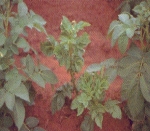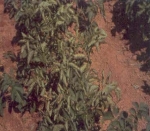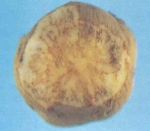Virus and virus-like diseases occur in potatoes wherever the crop is grown. We list seven. There are others, but they are rare or absent in this area. Viruses seldom affect eating quality (net necrosis, sometimes caused by the leafroll virus, is an exception) but yield is decreased. The viruses are passed through seed tubers and can spread extensively from plant to plant in the field. Thus, any crop with more than a small percentage of an important virus is a poor risk as seed. Certification standards have been set with this in mind.
Spread of several virus diseases is accomplished almost entirely by aphids, small insects which feed by puncturing the leaf or stem and sucking sap. Fortunately because of climate and geographic location of the Atlantic region of Canada, aphid populations tend to be limited. One of the major vectors of plant viruses, the green peach aphid, Myzus persicae, does not generally overwinter here. Aside from a few escapes from greenhouses and storerooms, a new population of M. persicae must emigrate into the region each year. As the potato crop matures, it becomes more resistant to new infections by viruses. Thus, it is upon the relative scarcity of aphids in general and the late arrival of M. persicae that our status as a seed-growing area depends.
In some years aphids develop in larger numbers or come earlier. It is then that there may be problems. The different viruses and control methods are briefly outlined here.
GENERAL CONTROL
Some control methods apply to several viruses and should be standard where high quality seed is to be grown.
Use seed of a grade appropriate to the intended use, but check post-harvest test results (laboratory or Florida) as a precaution. Tuber units are required for all Pre-Elite, E I and E II plantings. Tuber units greatly facilitate roguing. Planting small whole seed is less effective for roguing, but reduces the rate of spread of a number of viral, bacterial, and fungal diseases.
Choose, if possible, an isolated, windswept field where it is difficult for aphids to alight and move about in short flights.
Control weeds and volunteer potato plants within and about your field. Large aphid populations can develop on weeds such as shepherd's purse, wild mustard, and wild radish.
Aim at early maturity, particularly with long-season varieties such as Russet Burbank. Greensprout lightly (large sprouts break off), plant early and use less fertilizer than recommended for processing or table crops. Reducing nitrogen, in particular, hastens maturity and improves late season resistance to viruses, important in control of PLRV. Also, mature plants topkill more readily.
Rogue early and repeat several times. PVY symptoms usually develop earlier than those of PVA or PLRV. The job should be virtually complete when you can still walk the rows without contacting plants.
Eradicate groundkeepers. None of the potato viruses are known to survive the winter outdoors on any native plant in the Atlantic region. But viruses can survive in groundkeepers (tubers buried below the current season frost-line), which produce volunteer plants the following year. If these are a problem, crop rotation is essential. Eradication must be thorough, for new stems will quickly replace any that are merely cut down. Young volunteer plants are often quite resistant to herbicides.
Minimize machinery contact with foliage. PYX and PSTV are readily transmitted this way.
But there are some judgement decisions. The grower must weigh the costs versus benefit. These are discussed under the different viruses.
THE MOSAIC VIRUSES (PVV, PVA)
Viruses, Viroids and Mycoplasmas

Potato virus Y (PVY) causes mosaic-type symptoms on susceptible varieties, accompanied by a dropping of the lower leaves. The less common PV A causes a milder type of mosaic, without the leaf-drop. Resistant varieties are seldom infected with PVY in our fields. When this does happen, a crippling necrotic reaction takes place and only a few small tubers are produced. The virus practically eliminates itself. Varieties resistant to PVY, and several others that are susceptible, are virtually immune to PVA.
The mosaic viruses are known as "non-persistent" because aphids which transmit them can retain virus for only a short time. It is carried mostly on the stylet tips and seldom very far, but the occasional aphid can carry PVY for at least 400 metres. These viruses are spread largely by winged aphids, newly arrived in potato fields (not necessarily from other potatoes, as many develop on weeds). Very few of these aphids bring the virus with them but they can pick it up from diseased plants within the field and pass it on directly to healthy ones as they move about from plant to plant, probing with their stylets for a suitable place to feed. Sources of infection are mostly within the field or in fields close by; and this includes occasional volunteer plants from tubers that have survived the winter. None of our viruses are known to overwinter here in perennial plants.
The New Brunswick trials and seed inspection records lave shown that spread of PVY has been cyclic, with peaks at intervals of 9 to 10 years, since the seed inspection began in he early 1920s. (There is less data from other provinces, but some evidence of this cycle appears in records from Prince Edward Island.) The most recent peak years were 1968, 1978, and 1987. But spread is not intense in every year close to the peak. There has been a system of alternate high and low years of spread superimposed on the 9-10 year cycle, with an occasional double-low. During the years of high or relatively intense spread, this commences about July 1, whilst it starts two or three weeks later in the low years and is less intense for a shorter period. For, there has been little effective spread of PVY after the first week in August in any year, due to resistance that develops in mature plants. There has been relatively high spread in only 9 of the past 20 years, with no two in succession.
Control
- Aphicides -These have little value. Much money has been wasted in the mistaken belief that killing aphids within the field will control the spread of mosaic viruses. Aphicides should normally be used only to prevent excess population build-up of aphids. Most of the aphids caught in pan traps in the potato areas do not colonize potatoes, but merely alight and probe while moving about in search of a suitable host plant. Some of these aphids are known to transmit non-persistent viruses in other crops as well as the mosaic viruses in potatoes. Insecticides do not act quickly enough to prevent this type of virus spread. Nevertheless, at one of our government seed farms insecticide is applied early in July to annual ryegrass planted about the perimeter of each field and on roadways. Some aphids are killed before they reach the potatoes. We do not know the net effect of this particular measure, but the Florida test records of this farm are outstanding.
- Roguing -This should be done as early as possible for any useful effect in controlling PVY.
- Topkill -Most of the seasonal increment of mosaic virus has already reached the tubers before topkilling is practical.
- Oil Sprays -On varieties susceptible to PVY, oil sprays are a known means of control of PVY. However, these products are not registered in Canada for use on potatoes.
- Refer to General Controls.
POTATO LEAFROLL VIRUS (PLRV)

-PLRV causes loss of chlorophyll, rolling of the leaves (which take on a leathery texture) and often severe stunting of the plant. Yield can be significantly reduced. An aphid transmits PLRV (unlike the mosaic viruses) by ingesting virus into its stomach and later regurgitating it in saliva when it moves to feed on a healthy plant. The process takes longer, but the aphid remains infective as long as it lives. M. persicae, the green peach aphid, is by far the most effective vector of PLRV.
There are two sources of infection:
- Diseased plants in other fields, possibly hundreds of miles to the south, for aphids can carry PLRV long distances if wind is favorable.
- Diseased plants within the field. Aphids that do not already have the virus can acquire it by feeding or they can produce young on diseased plants and these will likely acquire virus as they feed and develop. They can then move about to infect other plants.

Epidemics of PLRV in the Maine-New Brunswick seed growing area have occurred periodically, for brief periods of years, typically reaching a climax during a particularly warm, dry summer. Just as the situation appeared to be out of control, the epidemic would collapse. Such was the case recently, following epidemics of 1971-1975 and 1985-1988. The collapse of each of these epidemics has followed the occurrence of one or two severe winters, with consequent reductions in the populations of Myzus persicae. Epidemics prior to 1971-1975 had occurred at longer intervals (1906-1912 and 1937-1945), but PLRV, which is a much greater problem in warmer climates, was favored by the particularly warm years of the 1980s. If climate warming continues, PLRV epidemics in this area will likely continue to be more frequent.
A problem that is very annoying to the consumer, net necrosis, is associated with first year infection with PLRV. It was common during the leafroll epidemics of the 1940s and 1970s in the varieties Green Mountain and Russet Burbank, but less so in recent years. Several other conditions can be mistaken for net necrosis. When in doubt, consult your seed potato inspector or potato specialist.
Control
- Aphicides -If leafroll is a problem in your area, a systemic insecticide at planting could suppress early season development of aphids within your field. Because it is less effective in controlling aphids that fly in from other potato fields later in the season, an aphicide may be advisable in late July or early August if the green peach aphid (see below) is colonizing potato fields in your area, but it is too early to topkill. Consult your provincial entomologist or potato specialist.
- Topkill -Though a number of different aphids are known to transmit the mosaic viruses, most leafroll virus transmission is done by the green peach aphid (Myzus persicae, Sulz.). Appearance of large numbers of winged M. persicae in August before the crop has matured, is a serious danger signal. Topkill is usually recommended within 10 days of significant flights of this aphid -roughly the time it takes virus to reach the tubers following infection of a leaf. Keep in touch with your provincial aphid-warning service, potato specialist, or your seed potato inspector. The kill must be complete. A partial topkill, with the development of new growth, can effectively rejuvenate the plant and attract aphids. This can be worse than no kill at all.
- Refer to General Controls.
THE LATENT VIRUSES (PVS, PVX)
-Some years ago, virtually all of our seed potatoes were infected with both PVS and PVX. Although they cause little if any symptoms on the plants, some yield reduction occurs. Today's seed has been derived from "basic seed" which was freed from viruses, including the latents. These two viruses can best be diagnosed by testing leaf or sprout samples in the laboratory by means of enzyme-linked immunosorbent assay (ELISA).
Though PVS can be transmitted by contact, it has been found in this area to be transmitted by aphids, much as are the mosaic viruses. In areas where the mosaic viruses are most common, the varieties susceptible to PVS (many of the same varieties susceptible to PVY) will tend to become re- infected. Some varieties have been found to be moderately resistant to PVS, but only Jemseg, posesses strong resistance.
So far as we know, PVX is transmitted only by mechanical contacts which transfer sap from one tuber or plant to another; e.g., handling, cutting knives, machinery. Given a seed-stock free of PYX, the careful grower can maintain his crop free of this virus.
POTATO SPINDLE TUBER VIROID (PSTV)
The viroid is mechanically transmitted. While never very common, it was once troublesome in our seed growing areas. It has been virtually eliminated from the area seed stocks in recent years by movement of healthy stocks from the provincial seed farms. Infected plants are upright in appearance, and tubers become elongated and sometimes cracked. Certification standards set zero tolerance for PSTV.
PURPLE TOP OR YELLOW TOP
This disease is caused by a mycoplasma which is transmitted by leafhoppers from some infected native plants. (The disease is better known as Aster Yellows). Symptoms are: a yellowish or purplish (according to variety pigmentation) discoloration of the uppermost leaves, with rolling and later wilting. The mycoplasma is not passed on through seed potatoes.
There are a number of virus, bacterial, and fungal diseases that occur in different parts of the world that would be undesirable in our area. Seed growers are largely dependent on plant pathologists, entomologists, the inspection service, and customs inspectors for protection against these diseases. Possible sources of entry into our region are in or on potato tubers, domestic and wild (including the species known as "fingerlings"), and living plants of a large number of species, and in soil. Further, these materials may also carry destructive insects. Persons importing such materials without going through proper quarantine channels subject Canadians to considerable risks.
